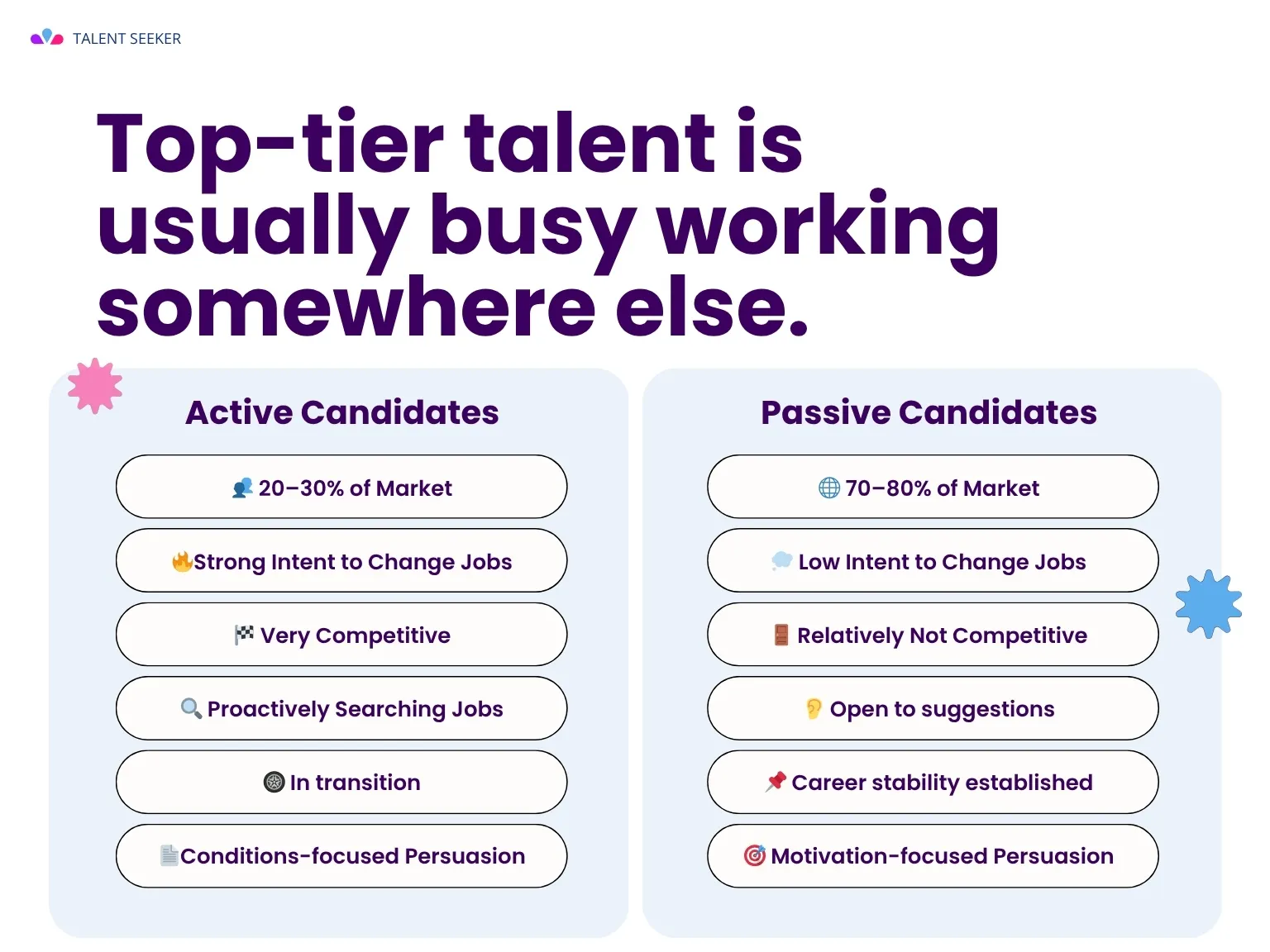Why Should We Care About Passive Candidates?
If you’ve ever tried to hire experienced professionals, this might sound familiar:
“We’re trying to bring in a senior frontend developer for the team,
but it’s been two weeks since we posted the job and all we’ve received are junior applicants or people with mismatched experience.”
The more specialized or senior the role is—especially those requiring specific tech stacks—the less likely it is that waiting for inbound applications alone will get you results. These “active candidates,” who are proactively seeking new jobs and apply to listings themselves, only represent a small portion of the talent market.
But our true target lies elsewhere:
Those who aren't actively looking but would consider a move if a better opportunity came along.
These are known as “passive candidates.” While they may appear uninterested in changing jobs right now, they actually make up 70–80% of the talent market. Most are steadily building their careers and are often open to hearing about new opportunities.
Category | Active Candidates | Passive Candidates |
Share of Market | ~20–30% | ~70–80% |
Intent to Change Jobs | Strong | Low or None |
Hiring Competition | Very High | Relatively Low |
Job Search Behavior | Proactively searching | Open to suggestions |
Career Stability | In transition | Career stability established |
Persuasion Strategy | Conditions-focused | Motivation&Opportunity-focused |
The reason recruiters should prioritize passive candidates is simple:
Top-tier talent is usually busy working somewhere else.
Proactive outreach, paired with a well-thought-out proposal for their next career step, is where good hiring really begins.
Why Does Hiring Passive Candidates Feel So Difficult?
Many recruiters view hiring passive candidates as something important but difficult.
And it’s not just because those candidates are hard to find.
It’s because once they’re found, most teams aren’t sure how to approach or persuade them.
Reason 1: Unclear where and how to find them
•
Recruiters used to job postings often find direct outreach (like DMs) unfamiliar and intimidating.
•
While they know about channels like LinkedIn or GitHub, they struggle to tell who might actually respond.
Reason 2: Writing personalized messages is not second nature
•
This isn’t just about pasting a job description—it requires a persuasive message tailored to the candidate’s career context.
•
Yet many teams still stick to generic lines like, “Are you open to new opportunities?”
Reason 3: Internal processes aren’t aligned with candidate expectations
•
Passive candidates don’t expect immediate offers—but once they show interest, your timing matters.
•
Unfortunately, many companies lose great candidates to slow decision-making structures.
Are We Actually Succeeding at Hiring Passive Candidates?
So what does the reality look like?
For many teams, hiring passive candidates remains an area where there’s intention, but little to no tangible results.
Only a few top-tier recruiting teams are leveraging this approach successfully—
the majority either try and fail, or never get started at all.
Reason 1: Only systemized teams see results
•
You can’t succeed with passive candidates through one-off attempts.
•
Only teams that track and improve key metrics—like response rate, open rate, and interview conversion—build long-term success.
Reason 2: Most teams use the same message for everyone
•
Many still send a single JD and standard message to both active and passive candidates.
•
Telling someone who isn’t job hunting, “Apply now!” often feels tone-deaf or pushy.
Reason 3: Relationship-based recruiting isn’t established
•
Passive candidates require long-term nurturing—not short-term conversion.
•
But under pressure to deliver quick results, most teams simply don’t have the bandwidth to build lasting relationships.
5-Step Sourcing Strategy for Passive Candidates
Step 1: Who Are Passive Candidates?
The biggest reason passive candidates feel hard to approach is that
most recruiters aren’t sure who the actual targets should be.
Reaching out to someone who isn’t actively job hunting can feel awkward or even like a waste of time.
But that doesn’t mean all passive candidates are completely closed to change.
Categorizing Passive Candidates
Type | Description | Outreach Strategy |
No desire for change, very satisfied with current situation | Do not approach | |
Currently satisfied but interested in better opportunities | Primary target | |
Recently changed jobs but still tracking the market | Time-sensitive | |
Highly skilled but not visible on mainstream channels | Identify through behavior signals |
Step 2: Why Do People Consider Changing Jobs?
Passive candidates are not actively preparing to change jobs,
so simply showing them a job posting won't move them to act.
Instead, they respond when you touch on unresolved issues in their current work or career.
That’s why recruiters must understand the psychological triggers behind job changes.
Key Motivation | Description | Messaging Strategy |
Leadership Issues | Distrust in manager, lack of feedback | “Clear direction, regular 1:1 feedback, and a supportive team culture” |
Compensation or Benefits Dissatisfaction | Feels underpaid or undervalued | “Transparent and competitive compensation” |
Work-life Balance Breakdown | Burnout, disrupted personal life | “Flexible work environment,” “Autonomy-first culture” |
Lack of Growth Opportunities | No room to learn or expand roles | “Opportunities for role expansion,” “Challenging new projects” |
Organizational Instability | Uncertain future, frequent restructuring | “Stable growth and clear business outlook” |
•
“How does this role help resolve the candidate’s existing frustrations?”
•
“Is our organization able to solve problems their current company can’t?”
Step 3: Crafting Your Selling Points and EVP
With passive candidates, your goal isn't to push them to make a move—
it's to present a clearly better alternative they can consider.
To do this, structure your company's unique Employer Value Proposition (EVP) around four key pillars.
Instead of saying, “We have a great position for you,”
say something more like:
“We understand the challenges you may be facing, and here’s how our team can offer a better fit.”
Pillar | Question | Messaging Direction |
Mission Fit | What problems are we solving? | “Your personal mission aligns with the work we do” |
Growth Fit | How can this role grow their skills? | “Opportunities to expand your role and take on new challenges” |
People Fit | Who will they work with? | “Supportive peers and feedback-driven leaders” |
Life Fit | What’s the quality of life like? | “Flexible hours, remote work options” |
Competitive Positioning
•
Do we offer better tech stacks, broader responsibilities, or clearer growth paths than the industry average?
•
What pain points might they be experiencing in their current company—and how does our team solve those problems better?
Step 4: How to Write a Persuasive Message
When reaching out to passive candidates,
you’re not pitching a job post—you’re proposing the next chapter of their career.
Here’s a structure that works especially well:
1.
Personalized Opening:
“Hi [Name], I was really impressed by your recent [project/post/contribution].”
2.
Empathy + Purpose for Reaching Out:
“I know you’re already doing great work where you are, but I believe this opportunity aligns with the next step in your career.”
3.
Summary of Key Selling Points:
“We offer a [collaborative/team-first] culture and [a role with meaningful responsibility].”
4.
Soft CTA:
“Would you be open to a quick coffee chat sometime soon?”
•
“We’re urgently hiring right now…”
•
“Are you currently open to new opportunities?”
→ Instead of asking questions, make a thoughtful proposal.
→ Instead of pushing conditions, offer a meaningful opportunity.
•
“We have a great position I’d like to recommend.”
→ This focuses too much on the position, and not enough on why it matters to them.
TalentSeeker Tip
TalentSeeker integrates data from GitHub, Notion, LinkedIn, and more,
so you can search across multiple channels through a single interface.
We also recommends personalized outreach messages based on the candidate’s background and career trajectory.
Step 5: Timing and Follow-up Strategy
Passive candidates rarely respond or convert after just one or two messages.
What matters most is having a structured, phased approach and timing that aligns with their pace.
Remember:
The goal of this 3-step follow-up flow is not immediate conversion—it’s relationship building.
Stage | Goal | Action |
1st Touch | Awareness and Empathy | Send a personalized message with genuine understanding |
2nd Touch | Build Trust and Provide Info | Share detailed position info, team/organization intro, real project examples |
3rd Touch | Expand Contact & Invite Conversion | Suggest a coffee chat, informal networking, or Q&A session |
Don’t consider non-responses a failure.
Engaging passive candidates isn’t about winning now—it’s about preparing for the right opportunity later.
Career moves take time. Don’t be discouraged by short-term silence.
Approach it from a candidate pipeline management perspective.
TalentSeeker Tip
TalentSeeker lets you manage candidates by stage in the pipeline.
You can add notes, mark fit levels, and even automate relationship maintenance through AI-generated follow-up messages based on predefined workflows.
Instead of focusing only on people who are actively job hunting, we must learn how to talk to those who are “waiting for the right opportunity to come along.” Persuading passive candidates isn’t just about acquiring talent. It’s about offering someone a better environment, better teammates, and more meaningful work. That kind of proposal needs to be thoughtful, sincere, and never rushed.
Hiring is the beginning of a relationship.
So start today
by reaching out to one of the 300M+ professionals on TalentSeeker.










